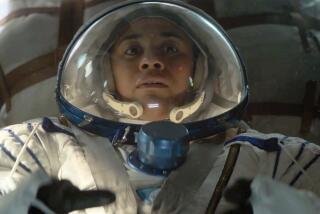The International Space Station, through the astronauts’ eyes
- Share via
Anyone who thinks the U.S. space program is done with and permanently parked at the California Science Center in the form of the space shuttle Endeavour hasn’t heard NASA astronaut Tracy Caldwell Dyson and aerospace engineer Camille Alleyne (yes, a rocket scientist) talk about the International Space Station. Which is what they were doing on a very earthbound mission this week in Los Angeles to promote NASA’s involvement in the space station and the exhibit, “Destination: Station,” showcasing what it’s like to live aboard the International Space Station. The exhibit is at the California Science Center through April 7.
But no one can be in a room with an astronaut and not talk about what it’s like to be in space. Caldwell Dyson, 44, lived and worked as a flight engineer aboard the space station for 174 days in 2010. During that time she made three spacewalks to remove and replace a failed pump module. (In addition to being an astronaut and holding a doctorate in chemistry from UC Davis, she has worked as an electrician. Let’s just say she’s handy.) Those spacewalks totaled 22 hours and 49 minutes in what space folks call EVA — extravehicular activity — time.
“When you come out and the sun is down, it’s so black you don’t realize there’s a planet below you,” she told an editorial board colleague and me during a visit to The Times. She wore a bright blue NASA jumpsuit, embroidered with so many flight patches that it made her look like a NASCAR driver. “I could get quite emotional describing it,” she said. But she didn’t. Instead, she sounded awestruck.
Two astronauts are always out in space at the same time and always connected in multiple ways to the actual ship. A safety tether was attached to Caldwell Dyson’s hip, while other leashes connected her to the areas where she was working. Handrails are strategically placed across the ship for holding on, and there are even foot platforms that can be extended from rigid tethers that allow the astronaut to step in and be held solidly in place while tinkering with tools.
Being on that foot platform, holding on to a spaceship traveling 17,500 miles an hour and looking down as you pass Earth, roughly 220 miles below, makes for an unusual experience. “I felt like I was hang gliding,” she said.
The space station is a partnership of five agencies: NASA, the Russian Federal Space Agency, the Japan Aerospace Exploration Agency, the European Space Agency and the Canadian Space Agency. Camille Alleyne, who holds the job of assistant program scientist for the station, describes it as an elaborate orbiting laboratory where research is being done that has significant ramifications for life on Earth, our knowledge about space itself and future commercial spaceflight.
A few things she mentions strike me as more quirky than important. In microgravity (where the force of gravity is so weak that everything is weightless), plant roots still grow down. OK.
But other things she mentions are huge: The structure of the protein that causes Duchenne muscular dystrophy was better crystallized in space (the crystals grow bigger and clearer in space) and advanced researchers’ understanding of how it works, which could lead to more effective treatment of the disease.
And, of course, there is the study of the human body in a weightless space vehicle for months on end. If commercial space travel ramps up, if we ever go to Mars, all that will be necessary to know. Six months of space travel — a one-way trip to Mars from Earth — can result in bone loss, muscle atrophy, even degraded vision. “Imagine sending people there and they’re so debilitated, they can’t do the work,” says Alleyne.
The International Space Station is set to continue its mission, at least, until 2024. But it takes a lot of time to plan and carry out this research. The question is whether politicians have the patience and foresight to allocate the funding for it.
ALSO:
Gun control made harder in California
The Iran I saw — in 781 days in Evin prison
On eggs, hens, and cages: Missouri is wrong and California is right
More to Read
A cure for the common opinion
Get thought-provoking perspectives with our weekly newsletter.
You may occasionally receive promotional content from the Los Angeles Times.










